Tp-link TD-W9970B, TD-W9970 User Manual
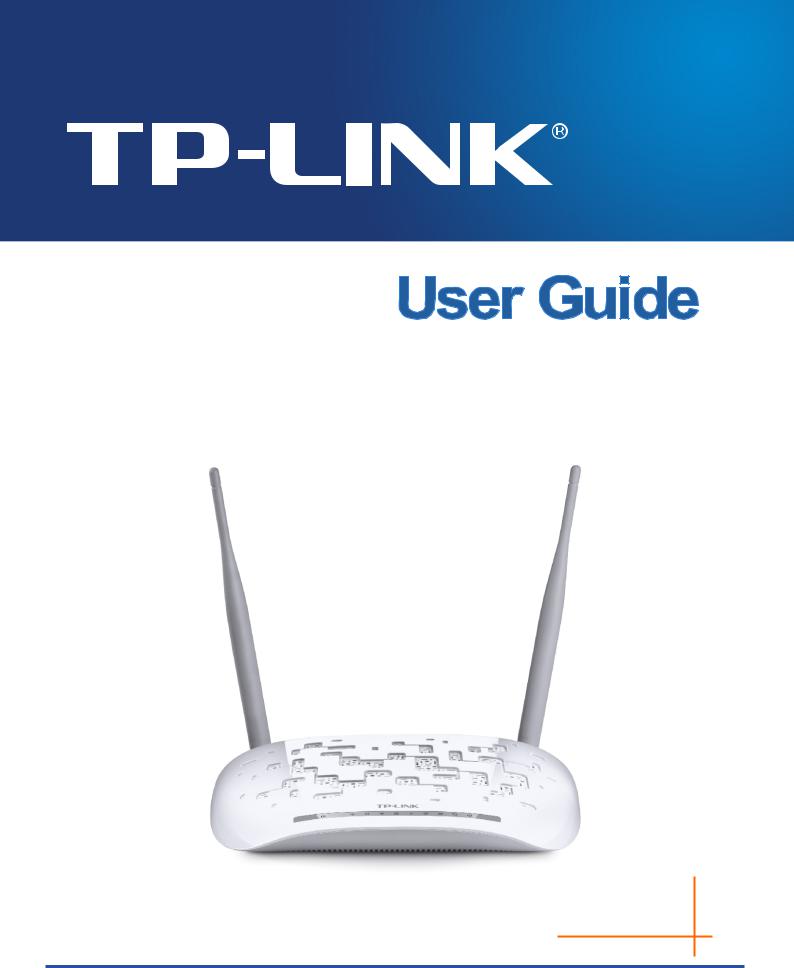
TD-W9970/TD-9970B
300Mbps Wireless N USB VDSL/ADSL Modem Router
Rev: 1.1.0
1910011604
COPYRIGHT & TRADEMARKS
Specifications are subject to change without notice.  is a registered trademark of TP-LINK TECHNOLOGIES CO., LTD. Other brands and product names are trademarks or registered trademarks of their respective holders.
is a registered trademark of TP-LINK TECHNOLOGIES CO., LTD. Other brands and product names are trademarks or registered trademarks of their respective holders.
No part of the specifications may be reproduced in any form or by any means or used to make any derivative such as translation, transformation, or adaptation without permission from TP-LINK TECHNOLOGIES CO., LTD. Copyright © 2016 TP-LINK TECHNOLOGIES CO., LTD. All rights reserved.
http://www.tp-link.com

FCC STATEMENT
This equipment has been tested and found to comply with the limits for a Class B digital device, pursuant to part 15 of the FCC Rules. These limits are designed to provide reasonable protection against harmful interference in a residential installation. This equipment generates, uses and can radiate radio frequency energy and, if not installed and used in accordance with the instructions, may cause harmful interference to radio communications. However, there is no guarantee that interference will not occur in a particular installation. If this equipment does cause harmful interference to radio or television reception, which can be determined by turning the equipment off and on, the user is encouraged to try to correct the interference by one or more of the following measures:
•Reorient or relocate the receiving antenna.
•Increase the separation between the equipment and receiver.
•Connect the equipment into an outlet on a circuit different from that to which the receiver is connected.
•Consult the dealer or an experienced radio/ TV technician for help.
This device complies with part 15 of the FCC Rules. Operation is subject to the following two conditions:
1)This device may not cause harmful interference.
2)This device must accept any interference received, including interference that may cause undesired operation.
Any changes or modifications not expressly approved by the party responsible for compliance could void the user’s authority to operate the equipment.
Note: The manufacturer is not responsible for any radio or tv interference caused by unauthorized modifications to this equipment. Such modifications could void the user’s authority to operate the equipment.
FCC RF Radiation Exposure Statement
This equipment complies with FCC RF radiation exposure limits set forth for an uncontrolled environment. This device and its antenna must not be co-located or operating in conjunction with any other antenna or transmitter.
“To comply with FCC RF exposure compliance requirements, this grant is applicable to only Mobile Configurations. The antennas used for this transmitter must be installed to provide a separation distance of at least 20 cm from all persons and must not be co-located or operating in conjunction with any other antenna or transmitter.”

CE Mark Warning
This is a class B product. In a domestic environment, this product may cause radio interference, in which case the user may be required to take adequate measures.
RF Exposure Information
This device meets the EU requirements (1999/5/EC Article 3.1a) on the limitation of exposure of the general public to electromagnetic fields by way of health protection.
The device complies with RF specifications when the device used at 20 cm from your body.
Продукт сертифіковано згідно с правилами системи УкрСЕПРО на відповідність вимогам нормативних документів та вимогам, що передбачені чинними законодавчими актами України.
Safety Information
When product has power button, the power button is one of the way to shut off the product; when there is no power button, the only way to completely shut off power is to disconnect the product or the power adapter from the power source.
Don’t disassemble the product, or make repairs yourself. You run the risk of electric shock and voiding the limited warranty. If you need service, please contact us.
Avoid water and wet locations.
Adapter shall be installed near the equipment and shall be easily accessible.
The plug considered as disconnect device of adapter.
 Use only power supplies which are provided by manufacturer and in the original packing of this product. If you have any questions, please don't hesitate to contact us
Use only power supplies which are provided by manufacturer and in the original packing of this product. If you have any questions, please don't hesitate to contact us

Explanation of the symbols on the product label
Symbol Explanation
DC voltage
RECYCLING
This product bears the selective sorting symbol for Waste electrical and electronic equipment (WEEE). This means that this product must be handled pursuant to European directive 2012/19/EU in order to be recycled or dismantled to minimize its impact on the environment.
User has the choice to give his product to a competent recycling organization or to the retailer when he buys a new electrical or electronic equipment.
|
|
CONTENTS |
|
Package Contents................................................................................................................ |
1 |
||
Chapter 1. Product Overview ............................................................................................ |
2 |
||
1.1 |
Overview of the Modem Router ........................................................................................ |
2 |
|
1.2 |
Main Features.................................................................................................................... |
3 |
|
1.3 |
Panel Layout...................................................................................................................... |
4 |
|
|
1.3.1 |
The Front Panel ........................................................................................................... |
4 |
|
1.3.2 |
The Back Panel ........................................................................................................... |
6 |
Chapter 2. Connecting the Modem Router.................................................................... |
7 |
||
2.1 |
System Requirements....................................................................................................... |
7 |
|
2.2 |
Installation Environment Requirements ............................................................................ |
7 |
|
2.3 |
Connecting the Modem Router ......................................................................................... |
8 |
|
Chapter 3. Quick Installation Guide................................................................................. |
9 |
||
3.1 |
TCP/IP Configuration ........................................................................................................ |
9 |
|
3.2 |
Quick Installation Guide .................................................................................................. |
10 |
|
Chapter 4. Configuring the Modem Router ................................................................. |
15 |
||
4.1 |
Login |
................................................................................................................................ |
15 |
4.2 |
Status............................................................................................................................... |
15 |
|
4.3 |
Quick Setup..................................................................................................................... |
17 |
|
4.4 |
Operation Mode............................................................................................................... |
17 |
|
4.5 |
Network............................................................................................................................ |
17 |
|
|
4.5.1 |
WAN Settings ............................................................................................................ |
18 |
|
4.5.2 |
3G/4G Settings .......................................................................................................... |
35 |
|
4.5.3 |
Interface Grouping ..................................................................................................... |
37 |
|
4.5.4 |
LAN Settings ............................................................................................................. |
39 |
|
4.5.5 |
IPv6 LAN Settings...................................................................................................... |
41 |
|
4.5.6 MAC Clone ................................................................................................................ |
43 |
|
|
4.5.7 |
ALG Settings ............................................................................................................. |
43 |
|
4.5.8 |
DSL Settings ............................................................................................................. |
45 |
|
4.5.9 |
IPSec VPN ................................................................................................................ |
45 |
4.6 |
IPTV................................................................................................................................. |
|
50 |
4.7 |
DHCP Server................................................................................................................... |
52 |
|
|
4.7.1 |
DHCP Settings .......................................................................................................... |
52 |
|
4.7.2 |
Clients List................................................................................................................. |
54 |
|
4.7.3 |
Address Reservation .................................................................................................. |
54 |
|
4.7.4 |
Conditional Pool......................................................................................................... |
55 |
4.8 |
Wireless........................................................................................................................... |
56 |
|
|
4.8.1 |
Basic Settings............................................................................................................ |
56 |
|
4.8.2 |
WPS Settings ............................................................................................................ |
58 |
|
4.8.3 |
Wireless Security ....................................................................................................... |
61 |
|
4.8.4 |
Wireless Schedule ..................................................................................................... |
63 |
|
4.8.5 |
Wireless MAC Filtering ............................................................................................... |
63 |
|
4.8.6 |
Wireless Advanced .................................................................................................... |
65 |
|
4.8.7 |
Wireless Status.......................................................................................................... |
66 |
4.9 |
Guest Network................................................................................................................. |
67 |
|
|
4.9.1 |
Basic Settings............................................................................................................ |
67 |
|
4.9.2 |
Guest Network Status ................................................................................................ |
68 |
4.10 |
USB Settings ................................................................................................................... |
69 |
|
|
4.10.1 USB Mass Storage ................................................................................................... |
69 |
|
|
4.10.2 User Accounts .......................................................................................................... |
70 |
|
|
4.10.3 Storage Sharing........................................................................................................ |
71 |
|
|
4.10.4 FTP Server............................................................................................................... |
72 |
|
|
4.10.5 Media Server ............................................................................................................ |
74 |
|
|
4.10.6 Print Server .............................................................................................................. |
75 |
|
4.11 |
Route Settings ................................................................................................................. |
76 |
|
|
4.11.1 Default Gateway ....................................................................................................... |
76 |
|
|
4.11.2 Static Route ............................................................................................................. |
76 |
|
|
4.11.3 RIP Settings ............................................................................................................. |
77 |
|
4.12 |
IPv6 Route Settings......................................................................................................... |
78 |
|
|
4.12.1 IPv6 Default Gateway ............................................................................................... |
78 |
|
|
4.12.2 IPv6 Static Route ...................................................................................................... |
78 |
|
4.13 |
Forwarding....................................................................................................................... |
79 |
|
|
4.13.1 Virtual Servers.......................................................................................................... |
79 |
|
|
4.13.2 Port Triggering.......................................................................................................... |
81 |
|
|
4.13.3 DMZ ........................................................................................................................ |
83 |
|
|
4.13.4 UPnP ....................................................................................................................... |
83 |
|
4.14 |
Parental Control............................................................................................................... |
84 |
|
4.15 |
Firewall ............................................................................................................................ |
85 |
|
|
4.15.1 Rule ......................................................................................................................... |
86 |
|
4.15.2 LAN Host ................................................................................................................. |
87 |
|
4.15.3 WAN Host ................................................................................................................ |
88 |
|
4.15.4 Schedule.................................................................................................................. |
89 |
4.16 |
IPv6 Firewall .................................................................................................................... |
90 |
|
4.16.1 IPv6 Rule ................................................................................................................. |
90 |
|
4.16.2 IPv6 LAN Host.......................................................................................................... |
92 |
|
4.16.3 IPv6 WAN Host ........................................................................................................ |
93 |
|
4.16.4 IPv6 Schedule .......................................................................................................... |
93 |
4.17 |
IPv6 Tunnel...................................................................................................................... |
94 |
4.18 |
Bandwidth Control ........................................................................................................... |
97 |
4.19 |
IP & MAC Binding............................................................................................................ |
98 |
|
4.19.1 Binding Settings........................................................................................................ |
98 |
|
4.19.2 ARP List................................................................................................................... |
99 |
4.20 |
Dynamic DNS................................................................................................................ |
100 |
4.21 |
Diagnostic...................................................................................................................... |
100 |
4.22 |
System Tools................................................................................................................. |
101 |
|
4.22.1 System Log ............................................................................................................ |
101 |
|
4.22.2 Time Settings ......................................................................................................... |
102 |
|
4.22.3 Manage Control ...................................................................................................... |
103 |
|
4.22.4 CWMP Settings ...................................................................................................... |
104 |
|
4.22.5 SNMP Settings ....................................................................................................... |
105 |
|
4.22.6 Backup & Restore................................................................................................... |
106 |
|
4.22.7 Factory Defaults ..................................................................................................... |
106 |
|
4.22.8 Firmware Upgrade .................................................................................................. |
107 |
|
4.22.9 Reboot ................................................................................................................... |
108 |
|
4.22.10 Statistics............................................................................................................. |
108 |
4.23 |
Logout ............................................................................................................................ |
110 |
Appendix A: Specifications ........................................................................................... |
111 |
|
Appendix B: Troubleshooting....................................................................................... |
112 |
|

TD-W9970/TD-W9970B 300Mbps Wireless N USB VDSL/ADSL Modem Router User Guide
Package Contents
The following contents should be found in your package:
One 300Mbps Wireless N USB VDSL/ADSL Modem Router
One Power Adapter for 300Mbps Wireless N USB VDSL/ADSL Modem Router
Quick Installation Guide
Technical Support card
One RJ45 cable
Two RJ11 cables
One DSL splitter
Note:
Make sure that the package contains the above items. If any of the listed items are damaged or missing, please contact your distributor.
1

TD-W9970/TD-W9970B 300Mbps Wireless N USB VDSL/ADSL Modem Router User Guide
Chapter 1. Product Overview
Thank you for choosing the TD-W9970/TD-W9970B 300Mbps Wireless N USB VDSL/ADSL Modem Router.
1.1 Overviewof the Modem Router
The modem router integrates 4-port Switch, Firewall, NAT-Router and Wireless AP. The Modem Router delivers exceptional range and speed, which can fully meet the need of Small Office/Home Office (SOHO) networks and the users demanding higher networking performance.
The modem router utilizes integrated VDSL2 transceiver and high speed MIPS CPU. The modem router supports full-rate VDSL2 connectivity conforming to the ITU and ANSI specifications.
In addition to the basic DMT physical layer functions, the VDSL2 PHY supports dual latency VDSL2 framing (fast and interleaved) and the I.432 ATM Physical Layer.
The modem router provides up to 300Mbps (2.4GHz) wireless connection with other 802.11n wireless clients. The incredible speed makes it ideal for handling multiple data streams at the same time, which ensures your network stable and smooth. The performance of this 802.11n wireless Router will give you the unexpected networking experience at speed much faster than 802.11g. It is also compatible with all IEEE 802.11g and IEEE 802.11b products.
With multiple protection measures, including SSID broadcast control and wireless LAN 64/128 WEP encryption, Wi-Fi protected Access (WPA2-PSK, WPA-PSK), as well as advanced Firewall protections, the modem router provides complete data privacy.
The modem router provides flexible access control, so that parents or network administrators can establish restricted access policies for children or staff. It also supports Virtual Server and DMZ host for Port Triggering, and then the network administrators can manage and monitor the network in real time with the remote management function.
Since the modem router is compatible with virtually all the major operating systems, it is very easy to manage. Quick Setup Wizard is supported and detailed instructions are provided step by step in this user guide. Before installing the modem router, please look through this guide to know all the modem router’s functions.
2

TD-W9970/TD-W9970B 300Mbps Wireless N USB VDSL/ADSL Modem Router User Guide
1.2 Main Features
Complies with IEEE 802.11n to provide a wireless data rate of up to 300Mbps (2.4GHz).
Four 10/100Mbps Auto-Negotiation RJ45 LAN ports (Auto MDI/MDIX), one RJ11 port.
Provides external splitter.
Adopts Advanced DMT modulation and demodulation technology.
Supports bridge mode and Router function.
Multi-user sharing a high-speed Internet connection.
Downstream data rates up to 100Mbps, upstream data rates up to 60Mbps.
Supports long transfers, the max line length can reach to 6.5Km.
Supports remote configuration and management through SNMP and CWMP.
Supports PPPoE, it allows connecting the internet on demand and disconnecting from the Internet when idle.
Provides reliable ESD and surge-protect function with quick response semi-conductive surge protection circuit.
High speed and asymmetrical data transmit mode, provides safe and exclusive bandwidth.
Compatible with all mainstreams DSLAM (CO).
Provides integrated access of internet and route function which face to SOHO user.
Real-time Configuration and device monitoring.
Supports Multiple PVC (Permanent Virtual Circuit).
Built-in DHCP server.
Built-in firewall, supporting IP/MAC filter and URL filter.
Supports Virtual Server, DMZ host and Port Triggering.
Supports Dynamic DNS, UPnP and Static Routing.
Supports system log and flow Statistics.
Supports firmware upgrade and Web-Management page.
Provides WPA-PSK/WPA2-PSK data security, TKIP/AES encryption security.
Provides 64/128-bit WEP encryption security and wireless LAN ACL (Access Control List).
Supports USB Storage Sharing, Print Server, FTP Server, Media Server.
Supports Ethernet WAN (EWAN).
Supports Bandwidth Control.
Supports IPv6.
Supports ADSL and VDSL.
3
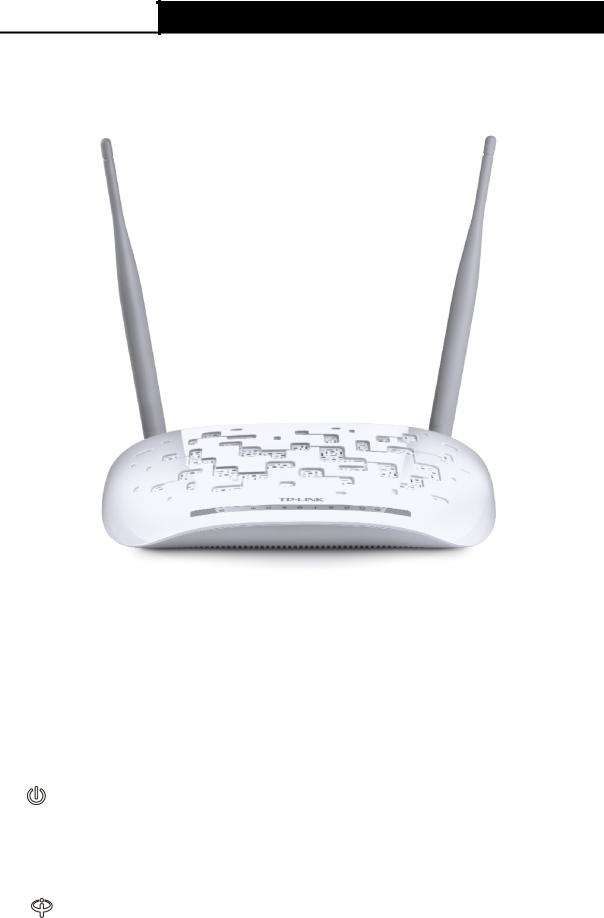
TD-W9970/TD-W9970B 300Mbps Wireless N USB VDSL/ADSL Modem Router User Guide
1.3 Panel Layout
1.3.1 The Front Panel
Figure 1-1
The modem router’s LEDs are located on the front panel (View from left to right). They indicate the device’s working status. For details, please refer to LED Explanation.
LED Explanation:
Name |
Status |
Indication |
|
|
|
|
On |
System start-up complete. |
|
|
|
(Power) |
Flash |
System starting up or device updating. |
|
|
|
|
Off |
The modem router is off. Please ensure that the power adapter is |
|
connected correctly. |
|
|
|
|
|
|
|
|
On |
DSL line is synchronized and ready to use. |
|
|
|
(DSL) |
Flash |
The DSL negotiation is in progress. |
|
|
|
|
Off |
There is no connection to the DSL Port or DSL synchronization |
|
|
|
|
|
|
4

|
TD-W9970/TD-W9970B |
|
300Mbps Wireless N USB VDSL/ADSL Modem Router User Guide |
|
||
|
|
|
|
|
|
|
|
|
|
|
|
fails. Please refer to Note 1 for troubleshooting. |
|
|
|
|
|
|
||
|
|
|
On |
The network is available with a successful Internet connection. |
||
|
|
|
|
|
|
|
|
(Internet) |
|
Off |
There is no successful Internet connection or the modem router |
||
|
|
|
is operating in Bridge mode. Please refer to Note 2 for |
|||
|
|
|
|
|
troubleshooting. |
|
|
|
|
|
|
||
|
(Wireless) |
|
On |
The wireless function is working properly. |
||
|
|
|
|
|
|
|
|
|
Off |
The wireless function is disabled. |
|||
|
|
|
||||
|
|
|
|
|
|
|
|
|
On/Off |
It turns on when a wireless device has been successfully |
|||
|
|
connected to the network via WPS. After about 5 minutes, the |
||||
|
|
|
|
|
WPS LED will turn off. |
|
|
(WPS) |
|
|
|
|
|
|
|
|
|
WPS handshaking is in process and will continue for about 2 |
||
|
|
|
Flash |
minutes. Please press the WPS/RESET button on other wireless |
||
|
|
|
devices that you want to add to the network while the LED is |
|||
|
|
|
|
|
||
|
|
|
|
|
flashing. |
|
|
|
|
|
|
||
|
|
|
On |
The USB device is identified and ready to use. |
||
|
|
|
|
|
||
|
(USB) |
|
Flash |
The USB device is being identified. |
||
|
|
|
|
|
||
|
|
|
Off |
No USB device is plugged in to the USB port. |
||
|
|
|
|
|
||
|
|
|
On |
There is a device connected to this LAN port. |
||
|
(LAN1-4) |
|
|
|
|
|
|
|
Off |
There is no device connected to this LAN port. |
|||
|
|
|
||||
|
|
|
|
|
|
|
Note:
1.If the DSL LED is off, please check your Internet connection first. Refer to 2.3 Connecting the Modem Router for more information about how to make Internet connection correctly. If you have already made a right connection, please contact your ISP to make sure if your Internet service is available now.
2.If the Internet LED is off, please check your DSL LED first. If your DSL LED is also off, please refer to Note 1. If your DSL LED is GREEN ON, please check your Internet configuration. You may need to check this part of information with your ISP and make sure everything have been input correctly.
3.You can also refer to 4.8.2 WPS Settings for more information.
5
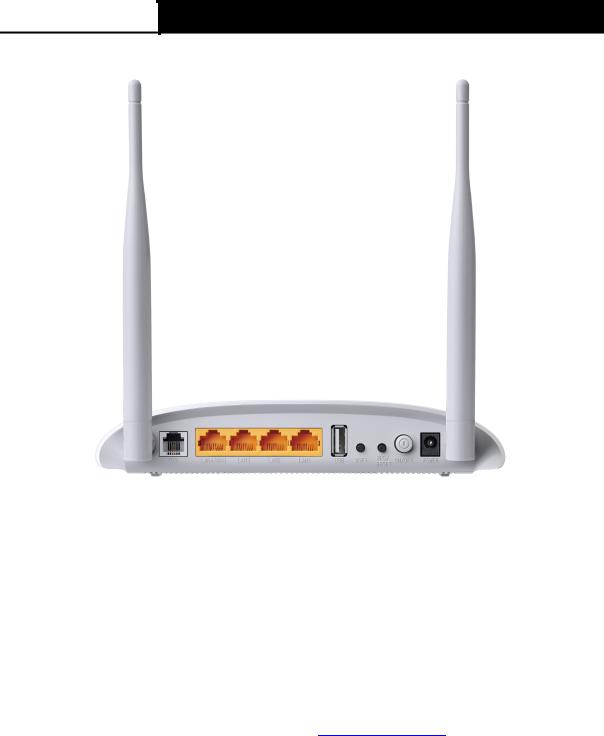
TD-W9970/TD-W9970B 300Mbps Wireless N USB VDSL/ADSL Modem Router User Guide
1.3.2 The Back Panel
Figure 1-2
VDSL: Through the port, you can connect the modem router with the telephone. Or you can connect them by an external separate splitter. For details, please refer to 2.3 Connecting the Modem Router.
LAN4/WAN, LAN3, LAN2, LAN1: Through these ports, you can connect the modem router to your PC or the other Ethernet network devices. In wireless router mode you will be able to connect to Cable/FTTH/VDSL/ADSL device.
USB: The USB port connects to a USB storage device, a USB printer or a 3G/4G Modem.
WiFi: The switch for the WiFi function. Press the button to enable/disable the WiFi function.
WPS/RESET: The switch for the WPS function or resetting the modem router.
•WPS function: For details, please refer to 4.8.2 WPS Settings.
•Reset the modem router: There are two ways to reset the modem router's factory defaults.
Method one: With the modem router powered on, use a pin to press and hold the WPS/Reset button for at least 5 seconds. And the modem router will reboot to its factory default settings.
Method two: Restore the default setting from 4.22.7 Factory Defaults of the modem router's Web-based management page.
ON/OFF: The switch for the power.
POWER: The Power plug is where you will connect the power adapter.
Antennas: Used for wireless operation and data transmit.
6

TD-W9970/TD-W9970B 300Mbps Wireless N USB VDSL/ADSL Modem Router User Guide
Chapter 2. Connecting the Modem Router
2.1 System Requirements
Broadband Internet Access Service (DSL/Cable/Ethernet).
PCs with a working Ethernet Adapter and an Ethernet cable with RJ45 connectors. TCP/IP protocol on each PC.
Web browser, such as Microsoft Internet Explorer, Mozilla Firefox or Apple Safari.
2.2 Installation Environment Requirements
The Product should not be located where it will be exposed to moisture or excessive heat.
Place the modem router in a location where it can be connected to the various devices as well as to a power source.
Make sure the cables and power cord are safely placed out of the way so they do not create a tripping hazard.
The modem router can be placed on a shelf or desktop.
Keep away from the strong electromagnetic radiation and the device of electromagnetic sensitive.
Generally, the modem router is placed on a horizontal surface. The device also can be mounted on the wall as shown in Figure 2-1.
Figure 2-1 Wall-mount install
7

TD-W9970/TD-W9970B 300Mbps Wireless N USB VDSL/ADSL Modem Router User Guide
Note:
The diameter of the screw, 3.5mm<D<7.8mm, and the distance of two screws is 107.5mm. The screw that project from the wall need around 4mm based, and the length of the screw need to be at least 20mm to withstand the weight of the product.
2.3 Connecting the Modem Router
Before installing the device, please make sure your broadband service provided by your ISP is available. If there is any problem, please contact your ISP. Before cable connection, cut off the power supply and keep your hands dry. You can follow the steps below to install it.
Step 1: Connect the DSL Line.
Method one: Plug one end of the twisted-pair DSL cable into the VDSL port on the rear panel of the modem router, and insert the other end into the wall socket.
Method two You can use a separate splitter. External splitter can divide the data and
voice, and then you can access the Internet and make calls at the same time. The external splitter has three ports:
•LINE: Connectto the wall jack
•PHONE: Connect to the phone sets
•MODEM: Connect to the VDSL port of the modem router
Plug one end of the twisted-pair DSL cable into the VDSL port on the rear panel of the modem router. Connect the other end to the MODEM port of the external splitter.
Step 2: Connect the Ethernet cable. Attach one end of a network cable to your computer’s Ethernet port or a regular hub/switch port, and the other end to the LAN port on the modem router.
Step 3: Power on the computers and LAN devices.
Step 4: Attach the power adapter. Connect the power adapter to the power connector on the rear of the device and plug in the adapter to an electrical outlet or power extension. The electrical outlet shall be installed near the device and shall be easily accessible.
Figure 2-2
8
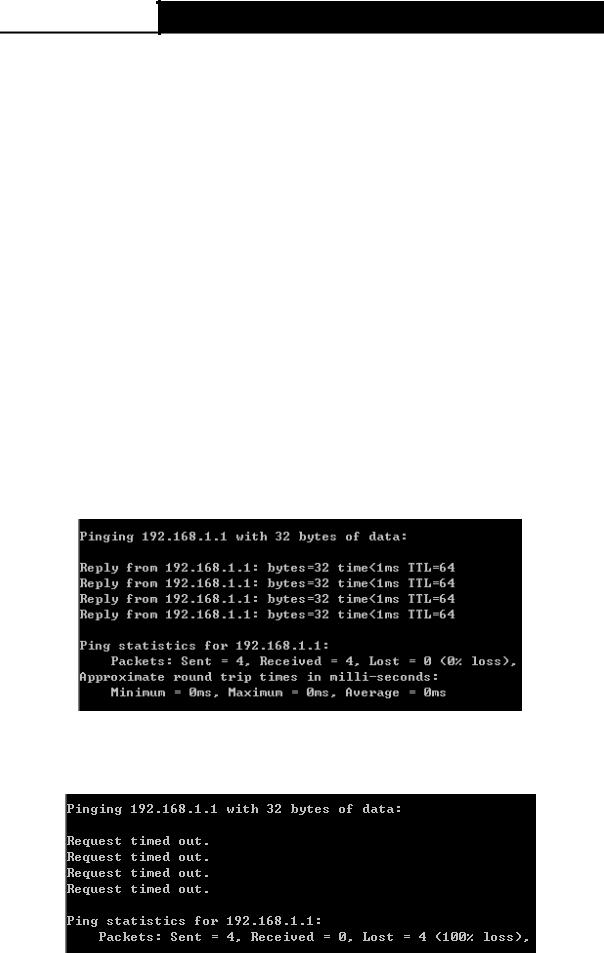
TD-W9970/TD-W9970B 300Mbps Wireless N USB VDSL/ADSL Modem Router User Guide
Chapter 3. Quick Installation Guide
This chapter will show you how to configure the basic functions of your modem router using Quick Setup Wizard within minutes.
3.1 TCP/IP Configuration
The default IP address of the modem router is 192.168.1.1. And the default Subnet Mask is 255.255.255.0. These values can be changed as you desire. In this guide, we use all the default values for description.
Connect the local PC to the LAN/WAN port of the modem router. And then you can configure the IP address for your PC in the following way.
Obtain an IP address automatically
1)Set up the TCP/IP Protocol in "Obtain an IP address automatically" mode on your PC. If you need instructions as to how to do this, please refer to Appendix B: Trouble shooting.
2)Then the built-in DHCP server will assign IP address for the PC.
Now, you can run the Ping command in the command prompt to verify the network connection. Please click the Start menu on your desktop, select run tab, type cmd or command in the field and press Enter. Type ping 192.168.1.1 on the next screen, and then press Enter.
If the result displayed is similar to the screen below, the connection between your PC and the modem router has been established.
Figure 3-1
If the result displayed is similar to the screen shown below, it means that your PC has not connected to the modem router.
Figure 3-2
9
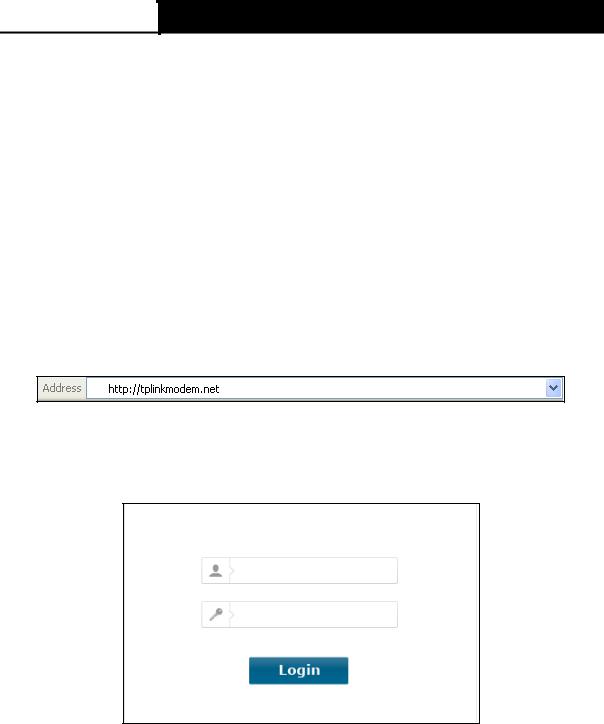
TD-W9970/TD-W9970B 300Mbps Wireless N USB VDSL/ADSL Modem Router User Guide
You can check it following the steps below:
1)Is the connection between your PC and the modem router correct?
The LEDs of LAN port which you link to the device and the LEDs on your PC's adapter should be lit.
2)Is the TCP/IP configuration for your PC correct?
If the modem router's IP address is 192.168.1.1, your PC's IP address must be within the range of 192.168.1.2 ~ 192.168.1.254.
3.2 Quick Installation Guide
With a Web-based management page, it is easy to configure and manage the modem router. The Web-based management page can be used on any Windows, Macintosh or UNIX OS with a Web browser, such as Microsoft Internet Explorer, Mozilla Firefox or Apple Safari.
1.To access the configuration utility, open a web-browser and type the default address http://tplinkmodem.net/ in the address field of the browser.
Figure 3-3
After a moment, a login window will appear, similar to the Figure 3-4. Enter admin for the Username and Password, both in lower case letters. Then click the Login button or press the
Enter key.
Figure 3-4
Note:
1)Do not mix up the username and password with your DSL account user name and password which are needed for PPP connections.
2)If the above screen does not pop up, it means that your Web-browser has been set to a proxy. Go to Tools menu→Internet Options→Connections→LAN Settings, in the screen that appears, cancel the Using Proxy checkbox, and click OK to finish it.
2.After your successful login, you will see the Quick Setup screen as shown in Figure 3-5. Click Next to continue.
10
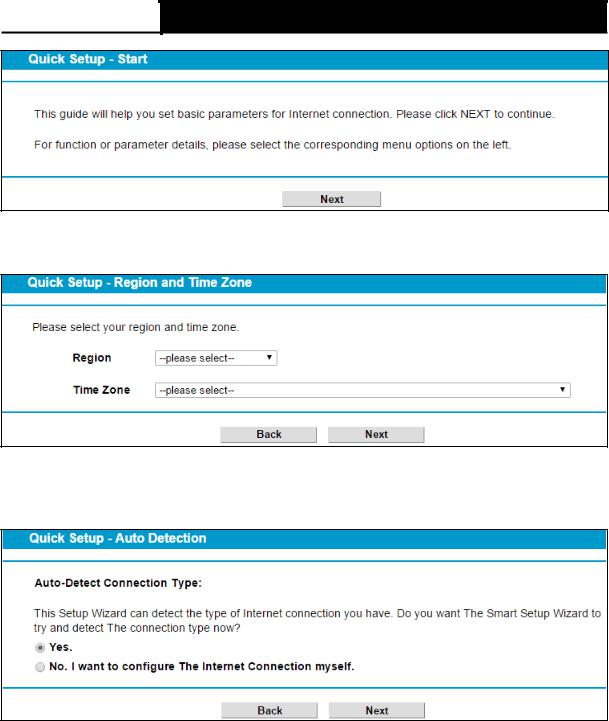
TD-W9970/TD-W9970B 300Mbps Wireless N USB VDSL/ADSL Modem Router User Guide
Figure 3-5
3.Select your Region and Time Zone from the drop-down list, then click Next.
Figure 3-6
4.Select “Yes” to auto detect your connection type and then click Next. It will take about two minutes, please wait.
Figure 3-7
5.Configure parameters for WAN connection. Here we take PPPoE as an example. Enter the username and password provided by your ISP. Click Next.
11
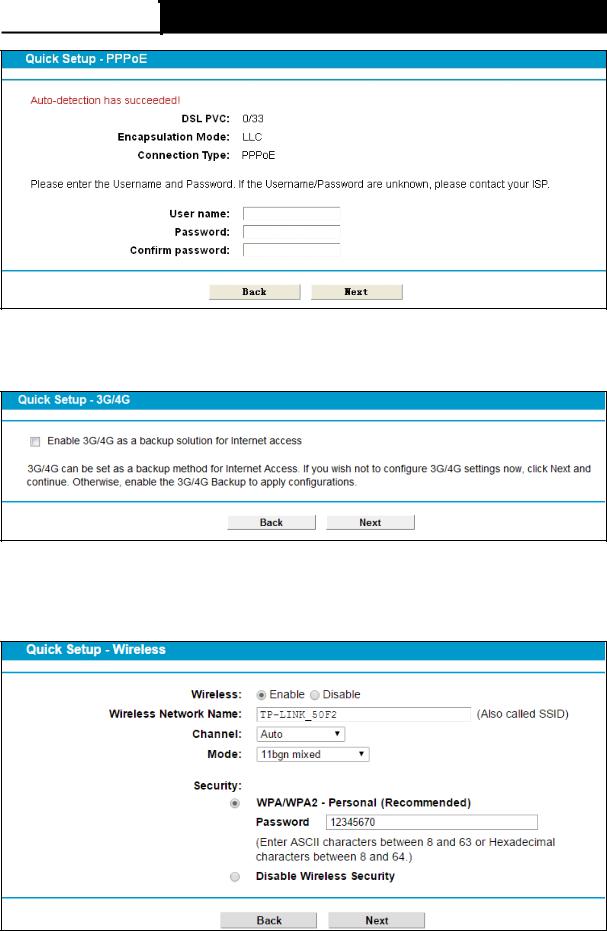
TD-W9970/TD-W9970B 300Mbps Wireless N USB VDSL/ADSL Modem Router User Guide
Figure 3-8
6.3G/4G Router Mode can be set as a backup Internet access method. If you do not want to configure 3G/4G settings now, just click Next to continue.
Figure 3-9
7.The wireless function is enabled by default. You can rename your wireless network name and create your own password in this page. The default wireless name is TP-LINK_XXXX. Click Next to continue.
Figure 3-10
12
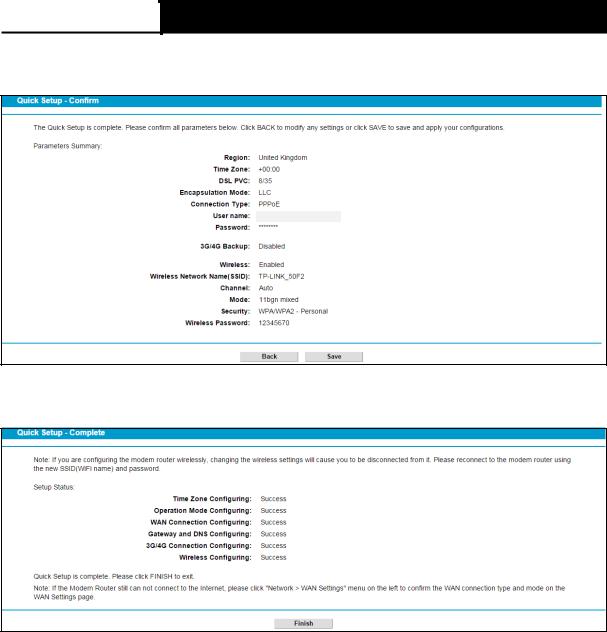
TD-W9970/TD-W9970B 300Mbps Wireless N USB VDSL/ADSL Modem Router User Guide
8.On this page, please confirm all parameters. Click Back to modify or click the Save button to save your configuration.
Figure 3-11
9.You will see the Complete screen below, click Finish to complete these settings.
Figure 3-12
13

TD-W9970/TD-W9970B 300Mbps Wireless N USB VDSL/ADSL Modem Router User Guide
Chapter 4. Configuring the Modem Router
This chapter will show each Web page's key function and the configuration.
4.1 Login
After your successful login, you will see the twenty-two main menus on the left of the Web-based management page. On the right, there are the corresponding explanations and instructions.
The detailed explanations for each Web page’s key function are listed below.
4.2 Status
Choose “Status”, you can see the corresponding information about Device Information, DSL,
WAN, LAN and Wireless.
14

TD-W9970/TD-W9970B 300Mbps Wireless N USB VDSL/ADSL Modem Router User Guide
Figure 4-1
4.3 Quick Setup
Please refer to Section 3.2 Quick Installation Guide.
4.4 OperationMode
Choose “Operation Mode”, and you will see the screen as shown in Figure 4-2. Select your desired mode and then click Save.
15
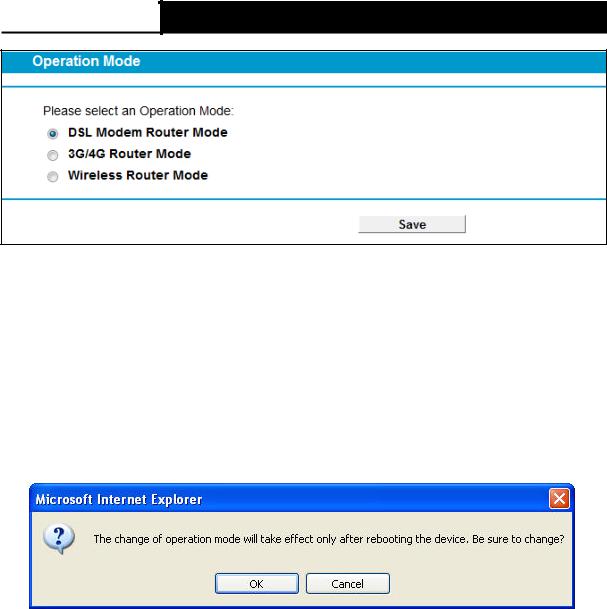
TD-W9970/TD-W9970B 300Mbps Wireless N USB VDSL/ADSL Modem Router User Guide
Figure 4-2
DSL Modem Router Mode: In this mode, the device enables multi-users to share Internet via ADSL/VDSL using its VDSL port and share it wirelessly at 300Mbps wireless 802.11n speeds.
3G/4G Router Mode: In this mode, the device allows multi-users to share a 3G/4G mobile broadband connection via wired or wireless connection.
Wireless Router Mode: In this mode, the device enables multi-users to share Internet via Ethernet WAN (EWAN) using its interchangeable LAN/WAN port and share it wirelessly at 300Mbps wireless 802.11n speeds.
After you click the Save button, the Note Dialog will appear. Click OK and then the modem router will reboot. Please wait.
Note Dialog
4.5Network
Choose “Network”, there are many submenus under the main menu. Click any one of them, and you will be able to configure the corresponding function.
16
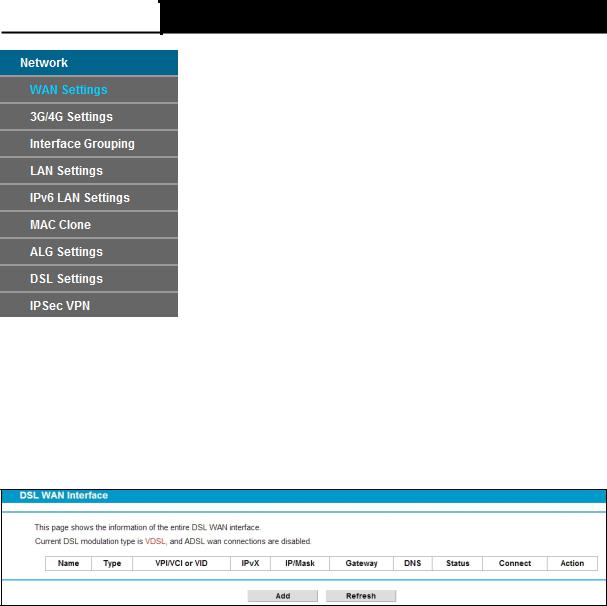
TD-W9970/TD-W9970B 300Mbps Wireless N USB VDSL/ADSL Modem Router User Guide
4.5.1 WAN Settings
Choose “Network”“WAN Settings”, and you will see the WAN Port Information Table in the screen similar to Figure 4-3.
4.5.1.1 VDSL WAN Settings
For VDSL mode, there are four different connection types, which are Static IP, Dynamic IP, PPPoE and Bridge. You can select the corresponding types according to your needs.
Figure 4-3
Click Add to add a new entry, you can configure the parameters for PTM and WAN Service in the next screen (shown in Figure 4-4).
17
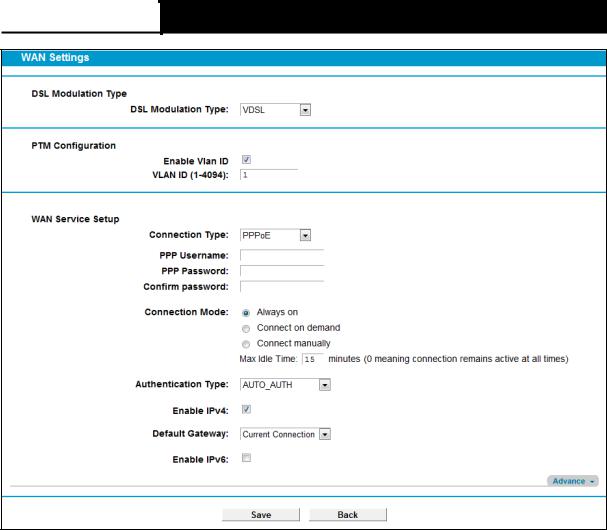
TD-W9970/TD-W9970B 300Mbps Wireless N USB VDSL/ADSL Modem Router User Guide
Figure 4-4
DSL Modulation Type:
DSL Modulation Type: The modem router supports two modulation types: ADSL and VDSL, you can select the corresponding types according to your needs.
PTM Configuration:
Enable VLAN ID: Check the box to enable the Virtual LAN ID.
VLAN ID (1~4049): This indicates the VLAN group, and the valid range is from 1 to 4049.
1) Static IP
Select this option if your ISP provides static IP information to you. You should set static IP address, IP subnet mask, and gateway address in the screen below.
18
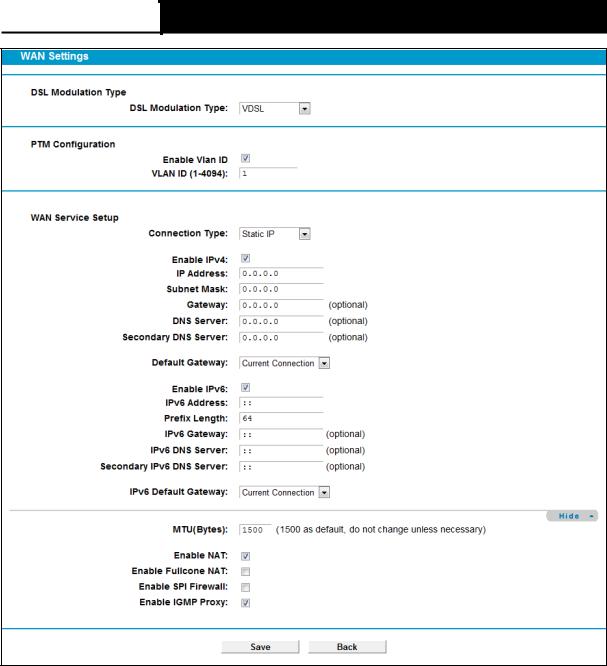
TD-W9970/TD-W9970B 300Mbps Wireless N USB VDSL/ADSL Modem Router User Guide
Figure 4-5
WAN Service Setup:
Enable IPv4 Check the box to enable IPv4.
IP Address: Enter the IP address in dotted-decimal notation provided by your ISP.
Subnet Mask: Enter the subnet Mask in dotted-decimal notation provided by your ISP, usually is 255.255.255.0.
Gateway (Optional): Enter the gateway IP address in dotted-decimal notation provided by your ISP.
DNS Server/ Secondary DNS Server: Here you can set DNS Server (at least one) manually. The Route will use this DNS Server for priority.
Default Gateway: Select a WAN Interface from the drop-down list as the IPv4 default gateway.
Enable IPv6: Check the box to enable IPv6.
19

TD-W9970/TD-W9970B 300Mbps Wireless N USB VDSL/ADSL Modem Router User Guide
IPv6 Address: Enter the IPv6 address provided by your ISP.
Prefix Length: Enter the prefix length of the IPv6 address. The default value is 64.
IPv6 Gateway: Enter the gateway IPv6 address provided by your ISP.
IPv6 DNS Server / Secondary IPv6 DNS Server: Here you can set IPv6 DNS Server (at least one) manually. The Route will use this IPv6 DNS Server for priority.
IPv6 Default Gateway: Select a WAN Interface from the drop-down list as the IPv6 default gateway.
Click Advance, advanced selections of WAN Service Setup can be shown.
MTU (Bytes): Maximum Transmission Unit Size. Check this box then you can change the MTU size. The default MTU value is 1500 Bytes. It is not recommended that you change the default value unless required by your ISP.
Enable NAT: This technology translates the IP addresses of a local area network to a different IP address for the Internet. If this modem router is hosting your network’s connection to the Internet, please select the check box. If another Router exists in your network, you don’t need to select the option.
Enable Fullcone NAT: It is a type of NAT, if not enabled, the default NAT will act.
Enable SPI Firewall: A SPI firewall enhances network’s security. Select the option to use a firewall, or else without a firewall.
Enable IGMP Proxy: IGMP (Internet Group Management Protocol) is used to manage multicasting on TCP/IP networks. Some ISPs use IGMP to perform remote configuration for client devices, such as the modem router. The default value is disabled, and if you are not sure, please contact your ISP or just leave it.
Click the Save button to save the settings.
2) Dynamic IP
Select this option, the modem router will be able to obtain IP network information dynamically from a DHCP server provided by your ISP.
20

TD-W9970/TD-W9970B 300Mbps Wireless N USB VDSL/ADSL Modem Router User Guide
Figure 4-6
Click Advance, advanced selections for WAN Service Setup can be shown.
MTU (Bytes): Maximum Transmission Unit Size. Check this box then you can change the MTU size. The default MTU value is 1500 Bytes. It is not recommended that you change the default value unless required by your ISP.
Enable NAT: This technology translates the IP addresses of a local area network to a different IP address for the Internet. If this modem router is hosting your network’s connection to the Internet, please select the check box. If another Router exists in your network, you don’t need to select the option.
Enable Fullcone NAT: It is a type of NAT, if not enabled, the default NAT will act.
Enable SPI Firewall: A SPI firewall enhances network’s security. Select the option to use a firewall, or else without a firewall.
Enable IGMP Proxy: IGMP (Internet Group Management Protocol) is used to manage multicasting on TCP/IP networks. Some ISPs use IGMP to perform remote configuration for client devices, such as the modem router. The default value is disabled, and if you are not sure, please contact your ISP or just leave it.
21
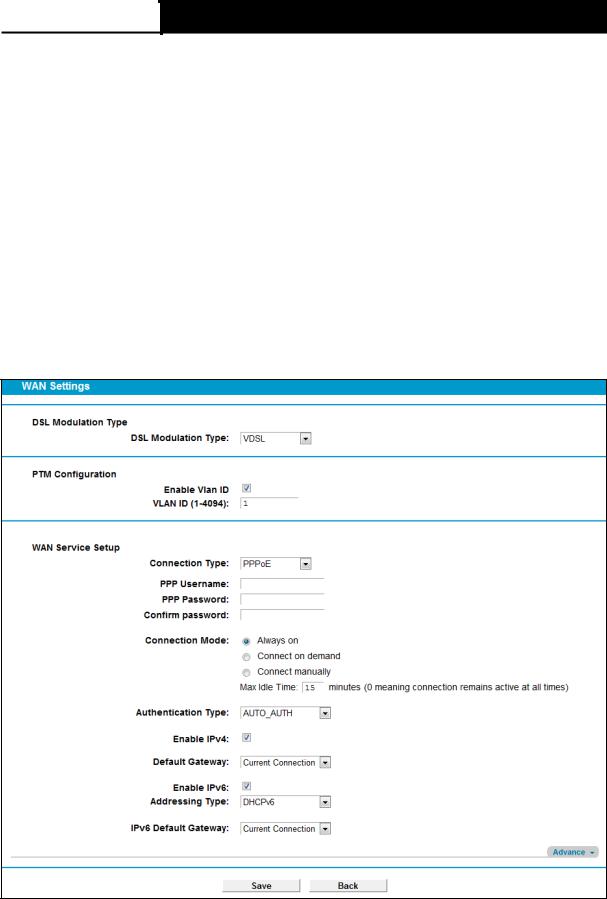
TD-W9970/TD-W9970B 300Mbps Wireless N USB VDSL/ADSL Modem Router User Guide
Get IP with Unicast: This is disabled by default. The minority of DHCP Server of ISP will not support to enable this. When the Route is connected right but IP cannot get, you can select this box.
Set DNS Server manually: Choose “Set DNS Server manually”, you can set DNS Server manually here. The modem router will use this DNS Server for priority.
Get IPv6 Address with Unicast: This is disabled by default. The minority of DHCPv6 Server of ISP will not support to enable this. When the modem router is connected right but cannot get IPv6 address, you can select this box.
Set IPv6 DNS Server manually: Choose “Set IPv6 DNS Server manually”, you can set IPv6 DNS Server manually here. The modem router will use this IPv6 DNS Server for priority.
Host Name: Here displays model No. of your modem router.
Click the Save button to save the settings.
3) PPPoE
If your ISP provides a PPPoE connection and you need to use an ATM Interface, choose PPPoE in the drop-down list, and then the screen will be displayed as below.
Figure 4-7
PPP Username/Password/Confirm password: Enter the User Name, Password and Confirm password provided by your ISP. These fields are case-sensitive.
22
